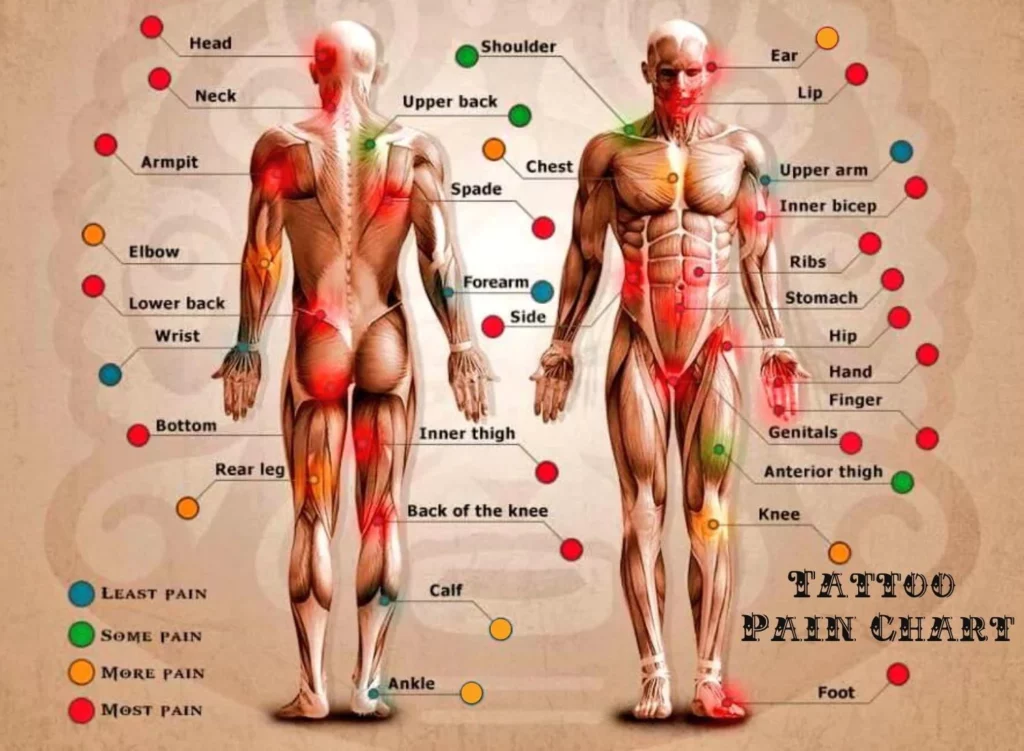Tattoo Pain Chart: How to Choose the Best Spot for Your Next Ink

Getting a tattoo is an exciting and rewarding experience, but it also involves some pain. The level of pain you’ll feel while getting a tattoo depends on several factors, including where on the body you plan to get the tattoo. Some areas are more sensitive and painful than others, due to the presence of nerve endings, bones, or thin skin. Knowing which spots are likely to hurt more or less can help you prepare for your tattoo session and choose the best location for your design.
In this article, we’ll explain how a tattoo pain chart works, what are the most and least painful places to get a tattoo, and how to minimize the pain and discomfort during and after the process.
What is a Tattoo Pain Chart?
A tattoo pain chart is a visual guide that shows how much pain you can expect to feel in different parts of your body when getting a tattoo. It usually uses a scale from 1 to 10, where 1 is the least painful and 10 is the most painful. The chart may also use colors or symbols to indicate the pain level.
A tattoo pain chart is not a definitive or scientific tool, but rather a general reference based on anecdotal evidence and personal experiences. The actual pain you’ll feel may vary depending on your individual pain tolerance, skin type, tattoo size and style, artist’s technique, and other factors.
However, a tattoo pain chart can still be useful to give you an idea of what to expect and help you make an informed decision about your tattoo placement.
Most Painful Places to Get a Tattoo
According to most tattoo pain charts, the most painful places to get a tattoo are those with many nerve endings, close to bones without much fat, or where your skin is very thin. These areas may cause you to feel high to severe pain when getting inked. Here are some examples of the most painful places to get a tattoo:
- Armpit: The armpit is one of the most sensitive areas of your body, with many nerve endings and lymph nodes. Getting a tattoo here may cause you to feel intense pain, as well as tickling or sweating sensations. Many tattoo artists advise against getting an armpit tattoo, as it can be very uncomfortable and difficult to heal.
- Rib cage: The rib cage is another area that has very thin skin and little fat covering the bones. Every time you breathe, you move your rib cage and the skin above it, which can make the tattooing process more painful and longer. The rib cage also has many nerve endings that can make you feel sharp or burning pain when getting inked.
- Ankles and shins: The ankles and shins are bony areas that have very little cushioning between the skin and the bone. Getting a tattoo here may feel like getting hit with a hammer or scraped with a knife. The ankles and shins also have many nerve endings that can make you feel more pain than other parts of your legs.
- Groin: The groin area is one of the most sensitive parts of your body, especially for women. It has many nerve endings that can make you feel extreme pain when getting a tattoo here. The groin area also has thin skin and delicate tissues that can be easily damaged by the needle. Getting a tattoo here may also cause bleeding, swelling, or infection.
- Spine: The spine is another bony area that has very little fat or muscle to protect it from the needle. Getting a tattoo here may feel like getting stabbed in the back or electrocuted. The spine also has many nerve endings that can make you feel more pain than other parts of your back.
- Neck: The neck is an area that has thin skin and many nerve endings that can make you feel more pain than other parts of your body. Getting a tattoo here may also cause you to feel pressure or tightness in your throat or head. The neck is also close to major blood vessels that can cause bleeding or bruising if punctured by the needle.
- Lips: The lips are one of the most sensitive parts of your face, with many nerve endings and blood vessels. Getting a tattoo here may cause you to feel intense pain, as well as swelling, bleeding, or infection. The lips also have thin skin that can fade or blur easily over time.
Least Painful Places to Get a Tattoo
According to most tattoo pain charts, the least painful places to get a tattoo are those with more fat, fewer nerve endings, and thicker skin. These areas may cause you to feel mild to moderate pain when getting inked. Here are some examples of the least painful places to get a tattoo:
- Forearm: The forearm is one of the most popular places to get a tattoo, as it is relatively easy to tolerate and heal. The forearm has thick skin and enough fat and muscle to cushion the needle. It also has fewer nerve endings than other parts of your arm, making it less sensitive to pain.
- Thigh: The thigh is another common place to get a tattoo, as it is large and fleshy. The thigh has enough fat and muscle to protect the bone and the skin from the needle. It also has fewer nerve endings than other parts of your leg, making it less painful to get inked.
- Back: The back is a large and flat area that can accommodate many tattoo designs. The back has thick skin and enough fat and muscle to cushion the needle. It also has fewer nerve endings than other parts of your body, making it less sensitive to pain. However, some areas of the back, such as the spine or the shoulder blades, may be more painful than others.
- Shoulder: The shoulder is a good place to get a tattoo, as it is relatively easy to tolerate and heal. The shoulder has thick skin and enough fat and muscle to protect the bone and the skin from the needle. It also has fewer nerve endings than other parts of your arm, making it less painful to get inked.
How to Minimize Tattoo Pain
While getting a tattoo will always involve some pain, there are some things you can do to minimize it and make the process more comfortable. Here are some tips on how to reduce tattoo pain:
- Choose a reputable and experienced tattoo artist: A good tattoo artist will use proper equipment, techniques, and hygiene practices to ensure your safety and comfort. They will also be able to adjust the speed, depth, and pressure of the needle according to your pain tolerance and skin type.
- Prepare yourself mentally and physically: Before getting a tattoo, make sure you are well-rested, hydrated, and nourished. Avoid alcohol, caffeine, drugs, or anything that can thin your blood or affect your mood. Try to relax and breathe deeply during the session, and focus on something else besides the pain.
- Apply numbing cream or spray: If you are very sensitive to pain or getting a tattoo in a very painful area, you may want to use a numbing cream or spray before or during the session. These products can temporarily block the nerve signals that cause pain, making you feel less discomfort. However, they may also affect the quality of your tattoo or cause allergic reactions, so consult with your tattoo artist before using them.
- Take breaks if needed: Depending on the size and complexity of your tattoo, the session may last from a few minutes to several hours. If you feel too much pain or discomfort, you can ask your tattoo artist to take a break or stop the session. However, keep in mind that taking too many breaks or stopping too often may prolong the healing process or affect the outcome of your tattoo.
Things to Consider Before Getting a Tattoo
Getting a tattoo is a big decision that requires careful consideration and planning. Here are some things you should think about before getting inked:
- The design: Choose a design that reflects your personality, style, or meaning. Make sure you are happy with it and that it suits your body type and placement. Avoid getting a tattoo that you may regret later, such as someone’s name, a trendy symbol, or something offensive.
- The cost: Getting a tattoo can be expensive, depending on the size, style, color, and location of your design. You may also need to pay for touch-ups, maintenance, or removal in the future. Make sure you have enough money to cover all the expenses involved in getting a tattoo.
- The risks: Getting a tattoo involves breaking the skin with a needle, which can expose you to various risks such as infection, allergic reaction, scarring, bleeding, or nerve damage. You may also experience pain, swelling, itching, or irritation during and after the process. Make sure you follow all the instructions from your tattoo artist on how to care for your tattoo properly and avoid any complications.
- The permanence: Getting a tattoo is a permanent decision that will stay with you for life. You may change your mind about it over time or want to get rid of it for personal or professional reasons. However, removing a tattoo can be difficult, painful, expensive, and not always effective. Make sure you are ready to commit to having a tattoo for life before getting one.
Conclusion
Getting a tattoo can be an exciting and rewarding experience that allows you to express yourself creatively and artistically. However, it also involves some pain that can vary depending on where on your body you get it.
A tattoo pain chart can help you understand how much pain you can expect to feel in different parts of your body when getting inked. It can also help you choose the best spot for your design based on your pain tolerance and preference.
However, keep in mind that a tattoo pain chart is not an exact science but rather a general reference based on personal experiences. The actual pain you’ll feel may

Very soon this web site will be famous among all blogging users,
due to it’s fastidious articles or reviews